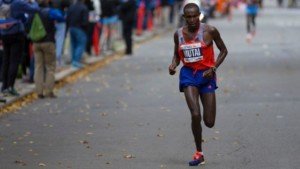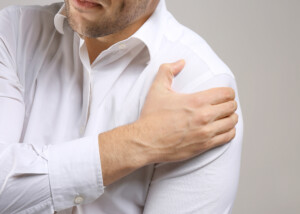
Maybe you’ve heard that a certain temperature is too hot for marathon running, but what’s the lowest temperature that may still be too hot?
As a marathon runner, you certainly know that the hotter the temperature, the more potentially unsafe it is to run long distances.
In one Rochester, Minnesota. race, the temperature hit 80 degrees by the event’s start, and 20 percent of finishers required IV fluids.
Marathon runners can still be at risk for heat related illness when the temperature is as low as just 65 degrees, says a report in Medicine and Science in Sports and Exercise, the science journal of the American College of Sports Medicine (ACSM).
The report states that marathons should be cancelled when the temperature hits 82-86 degrees.
ACSM recommends that in the event that a weather report predicts hot temperatures, race officials should begin the event earlier if they don’t cancel it.
Another recommendation from ACSM is that athletes put ego aside and walk part of the race if they begin feeling symptoms of heat illness.
Unfortunately, some runners don’t experience early signs of heat sickness, says the ACSM report.
What’s too Hot?
“There’s no absolutely right answer to this because the relative risk is different for different people,” says Dr. David Beatty, MD, a retired general practitioner with 30+ years of experience and an instructor of general medicine for 20 years.
“For most people who run a marathon it’s the most physically demanding thing they will do in their lives. This inevitably involves a degree of risk.”
Variables make the answer to this question difficult to answer such as cloud cover, available medical support at the marathon event, number of elite runners, individual fitness of the athletes, etc.
And some marathon runners thrive in the heat and have even stated that they prefer it over colder conditions.
“The American College of Cardiologists (in 2009) found the risk of death to be 0.8 per 100,000 runners,” continues Dr. Beatty.
“The London Marathon has been run for just over 40 years and there have been 12 fatalities.
“About 1-2 runners per 1,000 have to attend hospital. Well over a million people have taken part.
“The Sahara Marathon is a race of about 150 miles run over six days.
“This is, obviously, only taken on by ultra-fit athletes, and the temperature can be as high as 120 degrees F.
“There have been three deaths over its 35 year history. The 2021 race was particularly brutal with over half of the competitors dropping out.”
Most Common Causes of Death Related to Marathons
“The most common causes of death are heart attack, heat stroke, hyponatremia (low blood sodium) and hyperthermia,” says Dr. Beatty.
“You’re less likely to get heat stroke if you’re physically fit and have trained well for the event.
“If your marathon time is three hours you’ll get a lot less sun exposure than if you take five or six hours.
“Being the right weight is important. If you’re 10% overweight that’s 10% extra energy you have to use to get round the course.
“This means your body is burning more calories and producing more heat in the process.”
How to Protect Yourself During a Marathon
“Protect yourself from the sun, wear a hat, use sunscreen and pick the shady areas to run in,” says Dr. Beatty.
“Take plenty of isotonic fluid to avoid dehydration. If you only drink water this can cause hyponatremia.
“You’ll be sweating out salt, and if you only take in water your blood sodium levels become more diluted.”
During the course of the marathon there are plenty of opportunities to grab fluids, as spectators are lined up holding plastic cups.
It’s interesting to speculate how many runners have passed up this opportunity, believing it would cut a few seconds off their time. But if they’re dehydrated, this will cut off time.
The water can also be used to splash over their body, and it’s not uncommon to see this when viewing a marathon.
Keep in mind that runners shouldn’t wait until they’re parched to drink water or isotonic fluids.
“Make sure you’re well-hydrated before the race and don’t stand around in the sun before the race starts,” adds Dr. Beatty.
“Wearing heavy, fancy dress costumes can only increase the risk of heat related problems.” Yes, it’s not unheard of for participants to do this.
Just because you’re not an elite athlete or trying to break a personal record doesn’t mean you’re immune to heat related illness.
Heat Sickness
“With heat stroke the body temperature can be elevated to over 104 degrees F,” says Dr. Beatty.
“There may be poor coordination, delirium or seizures. Symptoms might be headache, malaise, nausea, vomiting, fatigue, anxiety or chest pain.”
Clammy skin and dizziness are two more potential signs.
“The pulse and respiration rate may be rapid [out of proportion to the exertion]. Coma can occur in severe cases.”
“It can be quite hard to know when you’re developing heat sickness because many runners will have some of the above symptoms when extending themselves.
“When it’s hot you have to consider the heat risks more seriously, and if you are feeling worse than you should, for having run a given distance, you should stop, get in the shade, cool off and rehydrate.”
But didn’t primitive man do a lot of running in the heat?
Ancient man – the hunter-gatherer – certainly needed to run in order to survive.
But primitive peoples ran only when they had to, and this crucial running was over short distances to either catch prey or escape from prey.
There were no marathon runs. Instead, hunter-gatherers walked long stretches of distance. They listened to their bodies.
When they felt tired, they stopped and rested. They sought shade when possible.
So though the human body was designed to cover long distances, it was not designed to run 26 miles nonstop, let alone in as short a time as possible.
 Dr. Beatty has worked in primary medicine, surgery, accident and emergency, OBGYN, pediatrics and chronic disease management. He is the Doctor of Medicine for Strong Home Gym.
Dr. Beatty has worked in primary medicine, surgery, accident and emergency, OBGYN, pediatrics and chronic disease management. He is the Doctor of Medicine for Strong Home Gym.
 Lorra Garrick has been covering medical, fitness and cybersecurity topics for many years, having written thousands of articles for print magazines and websites, including as a ghostwriter. She’s also a former ACE-certified personal trainer.
Lorra Garrick has been covering medical, fitness and cybersecurity topics for many years, having written thousands of articles for print magazines and websites, including as a ghostwriter. She’s also a former ACE-certified personal trainer.
.


























